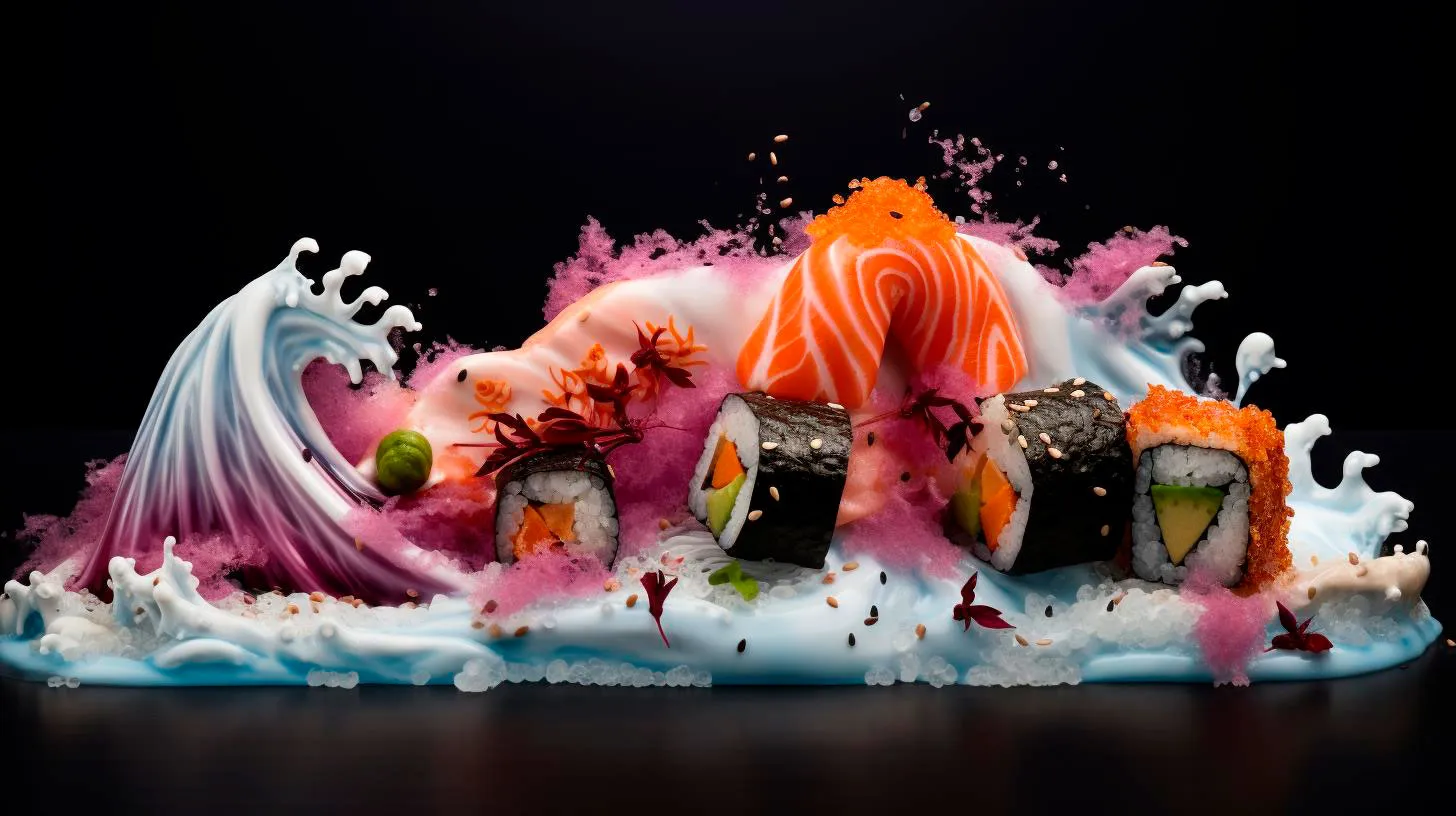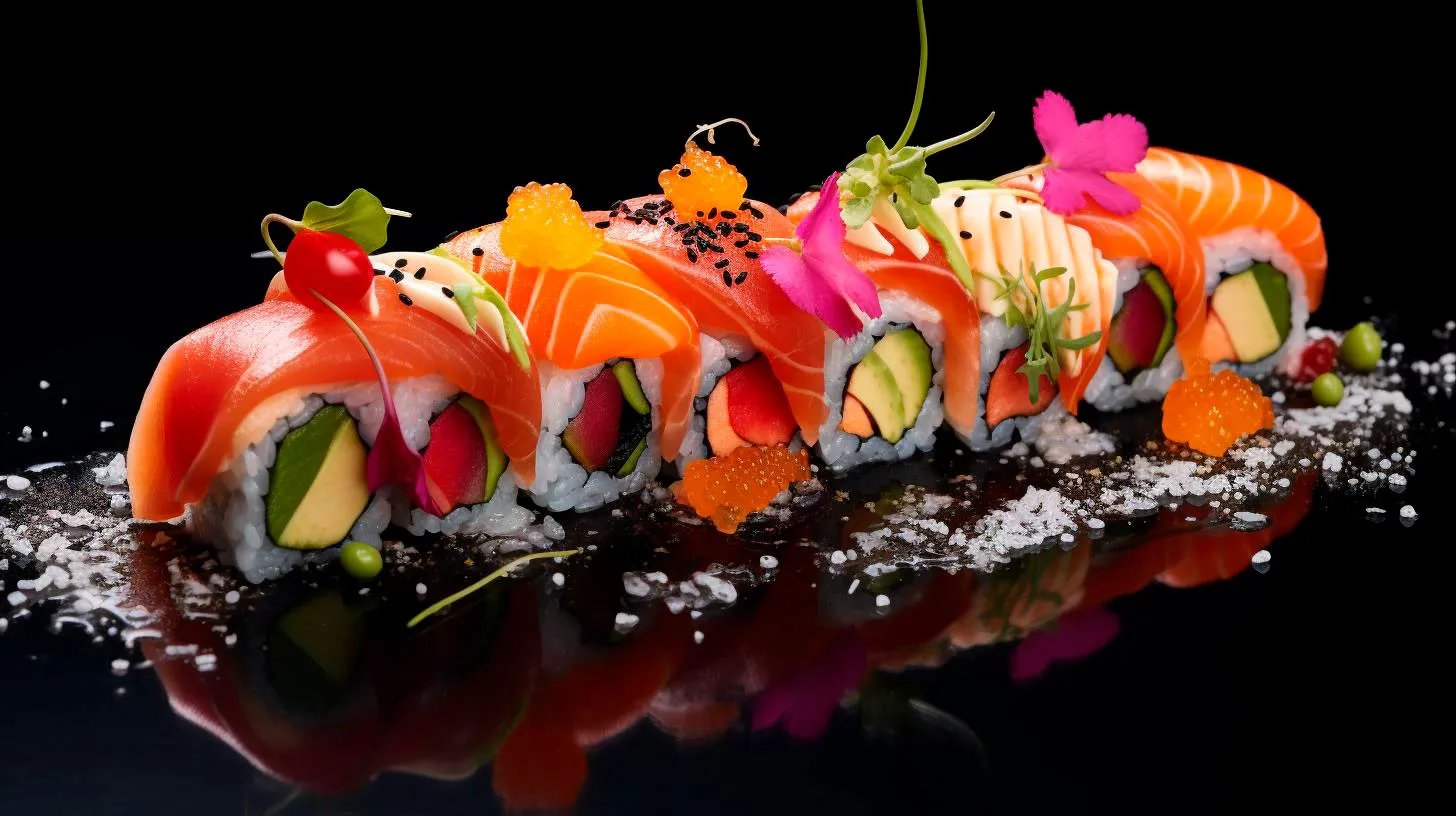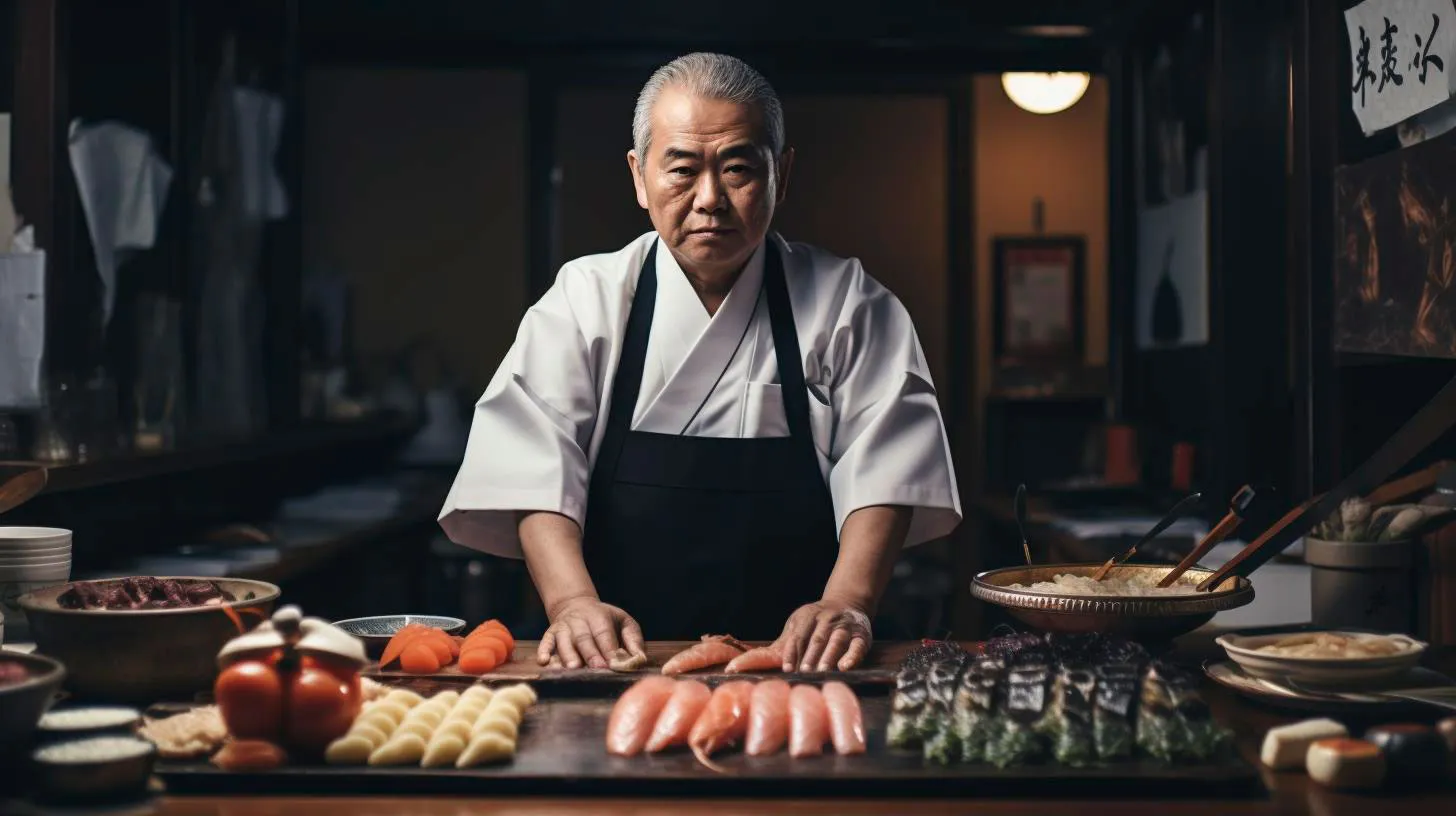From Rice Balls to Sashimi: The Diverse Delicacies of Japanese Sushi
From its humble origins as rice balls to the elegant art of sashimi, let’s explore the wonderful world of Japanese sushi.
The Origins of Sushi
Sushi, as we know it today, has evolved tremendously over centuries, but its roots can be traced back to ancient Southeast Asia. Originally, sushi was conceived as a way to preserve fish by fermenting it with rice and salt. During the 8th century, this preservation method made its way to Japan, and the Japanese soon developed their own unique method of sushi preparation.
As time passed, sushi transformed from a preservation technique into a delectable delicacy. During the Edo period (1603-1868), street vendors in Tokyo started selling nigiri sushi, which consisted of bite-sized portions of vinegared rice topped with fresh fish. This marked the beginning of what has become the most popular form of sushi worldwide.
The Sushi Revolution
In the mid-20th century, a sushi revolution occurred that propelled this traditional Japanese dish onto the global stage. The introduction of refrigeration and transportation systems allowed fresh fish to be transported across long distances. At the same time, Japanese chefs began experimenting with new ingredients and techniques, fusing traditional flavors with modern influences.
One of the most significant innovations during this period was the introduction of sushi rolls. Makizushi, or sushi rolls, are made by wrapping sushi rice, fish, and vegetables in a sheet of seaweed called nori. These rolls allowed for greater variety and flavor combinations, appealing to a broader audience.
The Different Types of Sushi
Japanese sushi encompasses a wide range of styles, each with its own distinct characteristics and flavors. Here are some popular types of sushi:
- Nigiri: Traditional hand-pressed sushi typically consisting of a small mound of vinegared rice topped with a piece of fresh fish or other ingredients.
- Sashimi: Thinly sliced raw fish or seafood served without rice. The emphasis is on the quality and freshness of the ingredients.
- Maki: Sushi rolls that combine sushi rice, fish, vegetables, and other fillings wrapped in nori.
- Temaki: Hand-rolled cones of nori filled with sushi rice, fish, and vegetables.
- Chirashi: A bowl of sushi rice topped with a colorful assortment of fish, vegetables, and other garnishes.
The Health Benefits of Sushi
Sushi not only delights the taste buds but also offers several health benefits. Here are some key takeaways:
- Sushi is generally low in calories and high in nutrients, making it a nutritious choice for those looking to maintain a balanced diet.
- Raw fish used in sushi is an excellent source of high-quality protein.
- The inclusion of seaweed in sushi provides a good source of vitamins, minerals, and antioxidants.
- The omega-3 fatty acids found in fish like salmon and tuna have been linked to numerous health benefits, including reduced risk of heart disease.
The Art of Sushi
Sushi is not just a meal; it is a work of art. The careful preparation, presentation, and attention to detail make sushi a visual delight. For sushi chefs, the goal is not only to create a delicious dish but also to craft a visually stunning masterpiece. The vibrant colors, intricate arrangements, and precision knife skills all contribute to the aesthetic beauty of sushi.
Moreover, the art of sushi extends beyond the plate. A well-curated dining experience, including the ambiance, crockery, and even the interaction between the chef and the customers, all play a crucial role in elevating the sushi experience.
Conclusion
Japanese sushi stands as a testament to Japan’s rich culinary heritage and its commitment to precision and excellence. From its humble beginnings as rice balls to the elegant sashimi, sushi has captivated the world with its diverse flavors and artful presentation. Whether you are a sushi aficionado or new to this mouth-watering cuisine, exploring the various types of sushi is an adventure worth embarking on. So, the next time you find yourself craving something extraordinary, indulge in the mesmerizing world of Japanese sushi.
The History of Sushi: A Culinary Journey of Traditions
Join us on a culinary journey as we explore the rich history and traditions behind sushi.
The Origins of Sushi
Sushi can be traced back over 1,000 years to ancient Japan. However, the sushi we know today is quite different from its original form. Originally, sushi was created as a way to preserve fish by fermenting it with rice and salt. The fermentation process helped preserve the fish, allowing it to be consumed even months later. Known as “narezushi,” this early form of sushi was not the bite-sized delicacy we enjoy today, but rather a way to store food.
Over time, the process of making sushi evolved, with the fermentation period being reduced. In the 18th century, a chef named Hanaya Yohei in Edo (now Tokyo) revolutionized sushi by creating nigiri sushi – the form of sushi we commonly see today. Instead of fermenting the fish, he started using fresh fish and combining it with vinegared rice. This new method not only preserved the fish better but also enhanced the flavor, making it more appealing to the masses.
The Spread of Sushi
Sushi gained significant popularity in Japan during the Edo period (1603-1868). During this time, the demand for sushi increased, and sushi stalls began to appear across the city. However, it was not until the Meiji era (1868-1912) that sushi truly began to spread beyond Japan’s borders.
With the advent of refrigeration in the late 19th century, sushi became easier to transport, enabling its introduction to other countries. The first sushi restaurant outside of Japan was opened in the United States in 1906. Since then, sushi has grown in popularity worldwide, with sushi restaurants serving a diverse range of sushi styles to cater to different tastes.
The Different Types of Sushi
Today, sushi is available in various forms, each with its unique characteristics and preparation methods. Let’s explore some of the most popular types:
- Nigiri: Consists of a slice of raw fish or seafood draped over a small mound of vinegared rice. Nigiri sushi is often served with a dab of wasabi between the fish and rice.
- Maki: Comprises a filling of fish, vegetables, or other ingredients wrapped in seaweed and rice. Maki rolls are then sliced into bite-sized pieces.
- Sashimi: Refers to thinly sliced raw fish or seafood served without rice. Sashimi is often accompanied by soy sauce, wasabi, and pickled ginger.
- Tempura: Involves lightly battered and fried seafood or vegetables served with rice. Tempura sushi adds a crispy element to the traditional sushi experience.
Sushi has also been influenced by other cuisines, leading to the creation of fusion sushi. In fusion sushi, traditional Japanese ingredients are combined with flavors from other cultures, such as spicy mayo or teriyaki sauce, to create innovative and exciting rolls.
The Health Benefits of Sushi
Aside from its delightful flavors, sushi also offers several health benefits. Here are some key takeaways:
- Rich in Omega-3 Fatty Acids: Fish used in sushi, such as salmon and tuna, contain high levels of omega-3 fatty acids, which promote heart health and reduce the risk of cardiovascular diseases.
- Low in Calories: Sushi rolls, especially those without mayonnaise or tempura, are generally low in calories, making them a healthier option than many other types of fast food.
- Good Source of Protein: Sushi provides a good source of protein, essential for building and repairing body tissues.
- Rich in Antioxidants: The addition of vegetables and seaweed in sushi provides a good source of antioxidants, which help protect against cell damage caused by free radicals.
Conclusion
Sushi, with its long-standing traditions and cultural significance, has become a beloved culinary experience worldwide. From its humble beginnings as a method of food preservation to its modern-day evolution, sushi continues to adapt and captivate food enthusiasts around the globe. Whether you prefer classic nigiri or experimental fusion rolls, sushi offers a delicious and healthy option for a memorable dining experience.
Sushi Chef Secrets: Mastering the Craft of Sushi Making
In this blog post, we will explore the secrets of sushi chefs and provide insights into mastering the craft of sushi making.
The Essence of Sushi
Before diving into the secrets of sushi making, let’s understand the essence of this traditional Japanese dish. Sushi is a culinary art form that emphasizes the balance of flavors, textures, and colors. It typically consists of vinegared rice (called “shari”) combined with a variety of fresh ingredients, such as fish, seafood, vegetables, and sometimes tropical fruits.
Sushi is not just about the taste; it is also a visual masterpiece. The presentation of sushi is carefully crafted, often resembling a work of art. Each ingredient is meticulously placed to create a stunning and aesthetically pleasing dish.
The Secrets of Sushi Chefs
1. Skillful Rice Preparation
The foundation of any great sushi dish lies in the proper preparation of the rice. Sushi chefs spend years perfecting their rice-cooking technique. They use short-grain rice, which is cooked to perfection and then seasoned with a mixture of rice vinegar, sugar, and salt. The rice should be sticky enough to hold its shape when formed into sushi rolls, yet each grain should retain its individual texture.
2. Knife Skills
One of the most essential skills a sushi chef must possess is mastery over their knives. They use razor-sharp knives to slice through fish and other ingredients with precision and finesse. Each cut is thoughtfully executed to create uniform pieces and maintain the integrity of the flavors.
3. Freshness and Quality of Ingredients
Sushi is all about freshness. Sushi chefs prioritize the quality of ingredients, especially the fish and seafood. They carefully select the freshest catch of the day, sourced from trusted suppliers. This ensures that the flavors are at their peak and the texture of the ingredients is perfect.
4. Attention to Detail
Attention to detail is paramount in sushi making. Each roll, nigiri, or sashimi is meticulously crafted, taking into consideration the color, texture, and taste of each ingredient. Sushi chefs pay attention to even the smallest details, such as the angle of the cut or the amount of wasabi placed on top of the fish.
5. Continuous Learning and Innovation
Great sushi chefs never stop learning. They strive to expand their knowledge of different flavor combinations, ingredients, and techniques. Successful sushi chefs are known for their ability to innovate and create unique sushi creations that surprise and delight their customers.
The Advantages of Mastering Sushi Making
Now that we have explored the secrets of sushi chefs, let’s understand the advantages of mastering the craft of sushi making:
- Creating your own sushi allows you to customize the flavors and ingredients to suit your taste preferences.
- It is a creative and enjoyable culinary hobby that can be shared with friends and family.
- Mastering the art of sushi making can open up opportunities for professional culinary careers.
- Preparing sushi at home can be a more cost-effective option compared to dining out.
- It provides the satisfaction of creating beautiful and delicious dishes from scratch.
Key Takeaways
Sushi making is a true culinary art form that requires years of practice and dedication to master. The secrets of sushi chefs lie in their skillful rice preparation, knife skills, attention to detail, and continuous quest for freshness and quality ingredients. By mastering the craft of sushi making, you can enjoy the advantages of customization, creativity, and potential career opportunities in the culinary industry.
So, why not embark on a sushi-making journey and uncover your own hidden talents in the world of sushi?
Sushi Etiquette: Unveiling the Art of Eating with Chopsticks
In this article, we will unravel the art of eating sushi with chopsticks, ensuring you can fully appreciate the experience while respecting the cultural norms. So, take a seat at the sushi counter and let’s dive in!
The Importance of Mastering Sushi Etiquette
Sushi etiquette is not merely a set of arbitrary rules but rather a profound reflection of Japanese culture and traditions. Adhering to these customs not only shows respect to sushi chefs, but it also enhances your overall dining experience. So, let’s explore the essential guidelines of sushi etiquette:
1. Chopstick Basics:
- Hold the chopsticks closer to the top, using your thumb and index finger
- Avoid pointing your chopsticks at others or spearing food with them
- Do not rub your chopsticks together, as it implies cheap quality
2. Proper Use of Soy Sauce:
- Use only a small amount of soy sauce for each piece of sushi
- Dip the sushi fish-side down to prevent the rice from absorbing excess soy sauce
- Be cautious not to let your sushi soak in the soy sauce for too long
3. Appreciate the Japanese Tradition:
- Acknowledge the chef’s skills with a polite greeting, such as “Itadakimasu” before you start your meal
- Try sushi without adding wasabi or soy sauce to fully appreciate the flavors
- Never separate the ingredients of sushi, as it is considered disrespectful
The Advantages of Sushi Etiquette
While sushi etiquette may seem daunting at first, it provides numerous benefits that enhance your dining experience. Understanding and respecting these customs can bring you the following advantages:
1. Enhanced Flavors:
- By delicately using chopsticks and adhering to the etiquette, you can fully savor the intricate flavors of each sushi piece
2. Respect for Tradition:
- Showing respect for Japanese culinary traditions deepens the cultural experience and fosters a sense of appreciation
3. Intimate Dining Atmosphere:
- Following sushi etiquette creates an intimate atmosphere and establishes a positive rapport with sushi chefs, who take pride in their craftsmanship
Key Takeaways for Mastering Sushi Etiquette
Mastering sushi etiquette demonstrates your respect for Japanese culture while enhancing your own dining experience. Remember these key takeaways to become a sushi connoisseur:
1. Handle Chopsticks with Grace:
- Hold your chopsticks correctly for smooth and precise movements
2. Use Soy Sauce Sparingly:
- Dip your sushi briefly into soy sauce, ensuring the fish side is submerged
3. Embrace Tradition:
- Greet the chef respectfully and avoid separating the ingredients of your sushi
4. Elevate Your Experience:
- Try sushi without any additional condiments to fully appreciate its delicate flavors
In conclusion, sushi etiquette is an invaluable part of the dining experience. By embracing these customs, you demonstrate respect for Japanese traditions and enhance your own taste journey. So, the next time you indulge in sushi, remember to wield your chopsticks with precision and immerse yourself in the elegance of this ancient culinary art.


